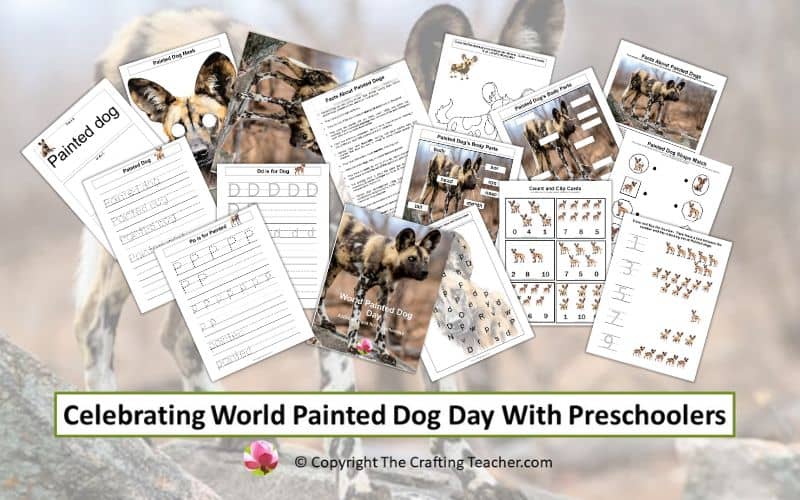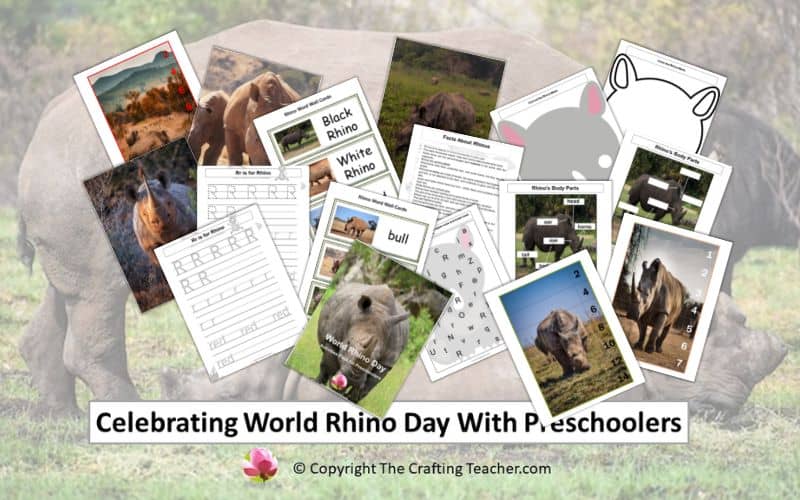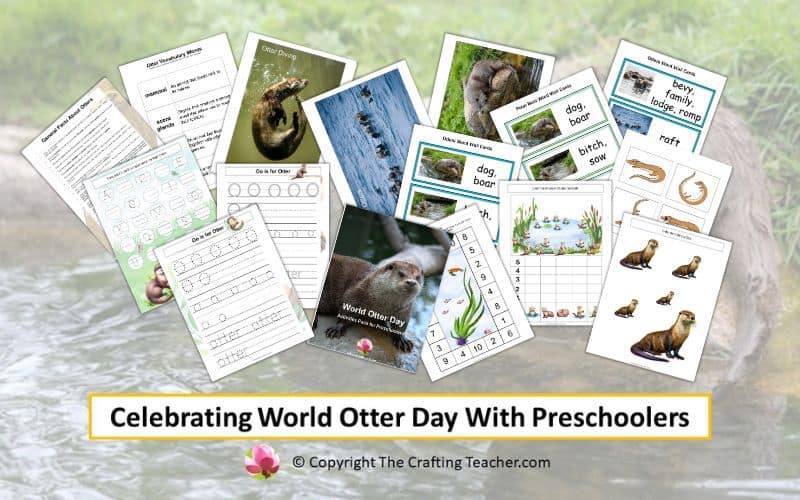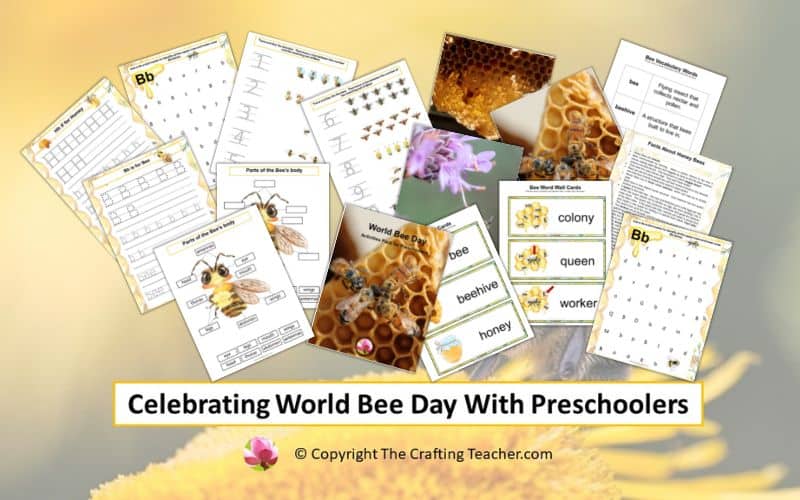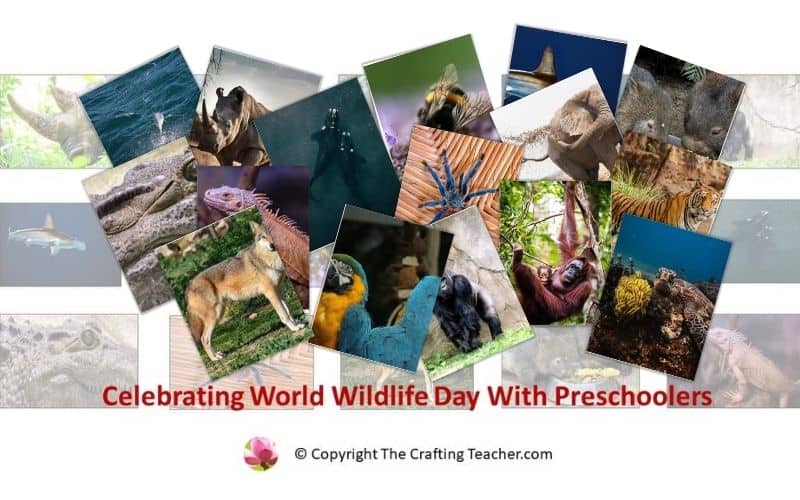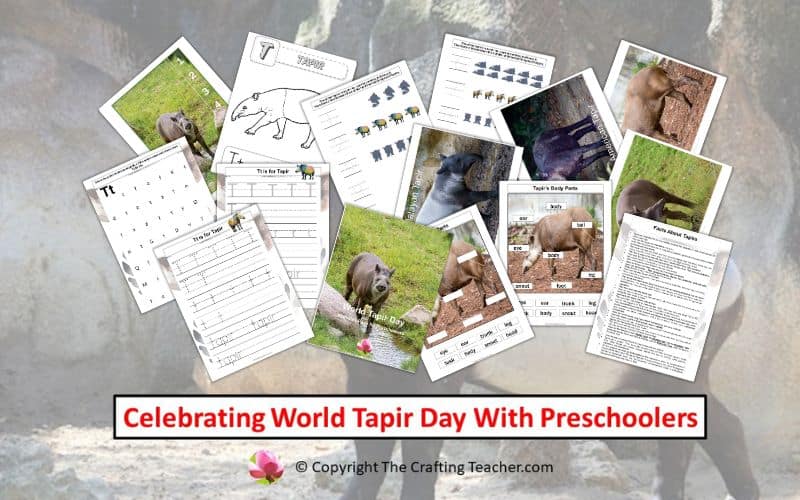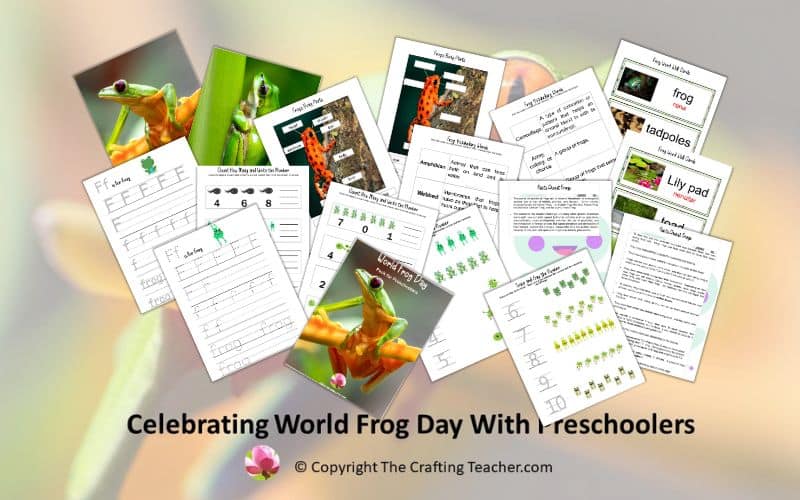Celebrating World Painted Dog Day with Preschoolers
Affiliate Disclosure: “This post contains affiliate links, which means I receive a small commission, at no extra cost, if you make a purchase using those links.”
World Painted Dog Day is celebrated on August 26th to raise awareness about the challenges these magnificent creatures face and how we can support the efforts of different organizations to save this species from extinction.
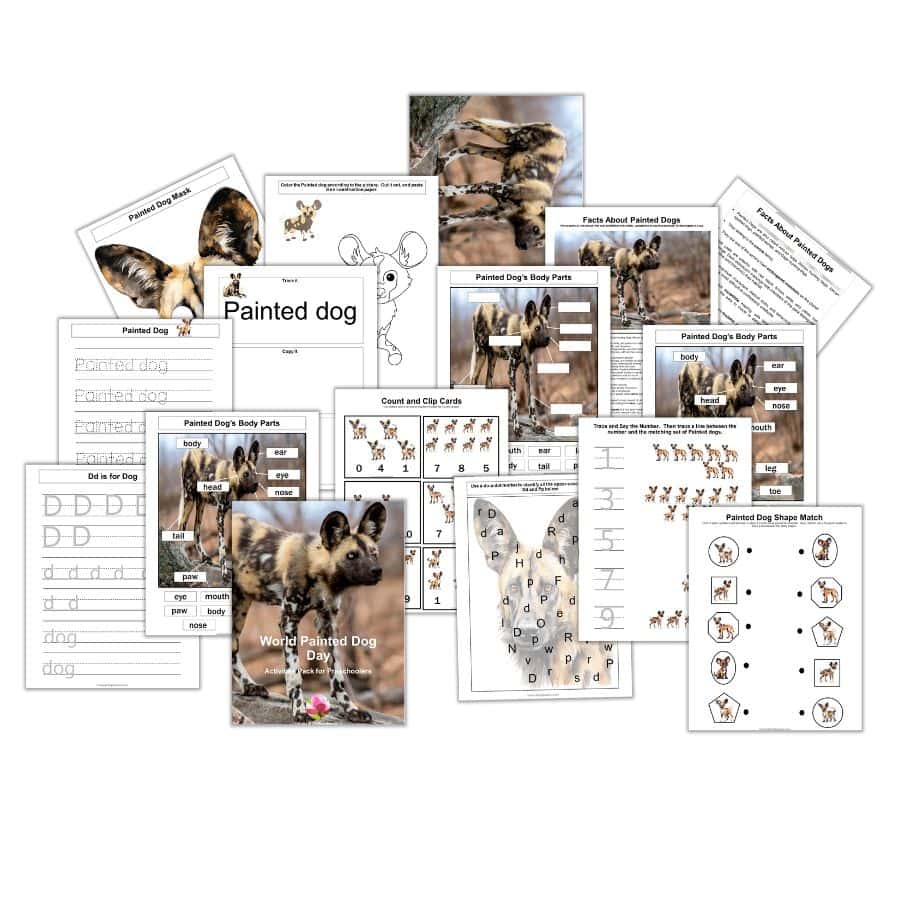
The FREE 27-page World Painted Dog Day activities pack, and the ideas I offer will help you celebrate this day while teaching your preschoolers about these animals. It includes Literacy, Science, Math, and Fine Motor activities and can be downloaded at the end of this post.
Conservationists Efforts
Many conservationist organizations are working together to protect this incredible species, focusing mainly on the following:
- Educating local communities to prevent conflicts and creating campaigns against the meat trade to reduce the use of snares to trap these dogs.
- Placing warning signs on roadsides.
- Constructing enclosures to protect livestock from predators and buying the ones killed by the wild dogs at a fair price to encourage farmers not to shoot the dogs.
- Distributing rabies vaccines for domestic dogs among communities to prevent wild dogs from contracting this disease.
- Monitoring local packs to understand their movements better
- Creating reserves to protect habitats and the packs and corridors to connect different areas allows the dogs to roam farther, move between packs to breed, and minimize contact with humans.
Some of the organizations supporting the Wild Painted Dogs are:
- The World Wildlife Fund (WWF).
- The Fauna & Flora Organization in Kenya, Mozambique Niassa National Reserve, and Southern National Park in South Sudan.
- The Ol Pejeta Conservancy in Kenya.
- David Shepherd Wildlife Foundation (DSWF) in and around Hwange National Park, Zimbabwe.
- The Painted Dog Conservation (PDC) in Zimbabwe.
- The African Wildlife Foundation in Zimbabwe.
- Going on a safari with National Geographic.
- The African Wildlife Foundation (AWF).
How You Can Help
- Get Informed – Learn everything you can about Wild Painted Dogs, and teach your preschoolers, family, and friends so they can also become their protectors.
- Do an Art Exhibit – Invite your children and their families to create a Painted Dog-inspired artwork, and prepare an exhibition for your families, friends, and community.
- Painted Dog Communication Challenge—After explaining to your children that painted use vocalizations, challenge them to do the same, trying to communicate with their friends using Painted Dog-like sounds.
- Painted Dog Cooperation Race – Explain to your preschoolers that you will divide them into two or three groups. Each group needs to devise a strategy to work together and transport water, toys, or any other items you want to use from one corner of the playground to the other before the other group or groups do it. This fun activity will help them learn essential skills such as cooperation, respect, and problem-solving.
- Organize a Field Trip – Find out if your local zoo has these animals in its collection, and organize a field trip with your preschoolers to see them, or invite your families to go if you can’t. Two zoos that do carry them are the Topeka Zoo and Conservation Center and the Oregon Zoo. These zoos will also offer multiple activities specially designed to celebrate this day.
- Use Books – Reading to your preschoolers is a powerful learning tool. Most books I know about Painted Dogs are nonfiction, but they are also packed with excellent illustrations and facts to help you teach your children about these animals. You can find my favorites below.
- Do Crafts – We all know that children love crafts. I found this cute Wild Dog Printable Craft on the learncreatelove.com website, which you can use.
- Promote Fundraising – Even a small donation can go a long way toward helping the organizations that protect wild painted dogs, such as the Flora and Fauna Organization and the David Shepherd Wildlife Foundation.
- Dress with Painted Dog-related Clothes – You and your children can wear a shirt that promotes curiosity and awareness about these dogs and their conservation, like this one, this one, this one, or this one.
- Include Toys in Your Centers – Offering new toys to play with is an excellent way to motivate preschoolers to ask questions about Painted Dogs and learn about them, especially if the toys are brand new. This African wild dog toy figure, this one, or this one could be excellent additions. Another idea is this African wild dog stuffed animal, or this one.
- Show Films and Documentaries About Painted Dogs – The best way for children to observe these elusive animals outside a zoo is to watch films and documentaries about them and their homes. Some good ones are African Wild Dogs Facts: the Painted Wolf, African Dogs Votes with Sneezes, and Killer Caretakers: Painted Dogs.
- Use Your Social Media – To create awareness, share ideas and information, and initiate petitions so others can get involved in the fight against the extinction of these fantastic and rare mammals.
- Visit and Promote Conservation Tourism – These dogs are elusive and rarely seen in the wild, but there are some places where they can be seen. These are the top wilderness camps you can visit.
- Adopt a Painted Dog – Of course, this type of adoption is just on paper, but the funds it provides are priceless. You can do it through the David Shepherd Wildlife Foundation and promote the idea among the people you know so they can do the same.
- Volunteer – To help with conservation projects that protect the African Wild Dogs.
Painted Dogs Facts
- Painted Dogs are also called African dogs, African hunting dogs, African spotted dogs, painted wolves, and Cape hunting dogs.
- They belong to the canine family.
- They are one of the world’s most endangered mammals.
- Their coats are colorful, with red, black, brown, white, and yellow hue markings unique to each dog. Each individual’s markings help members of the pack distinguish each other and blend into their habitat.
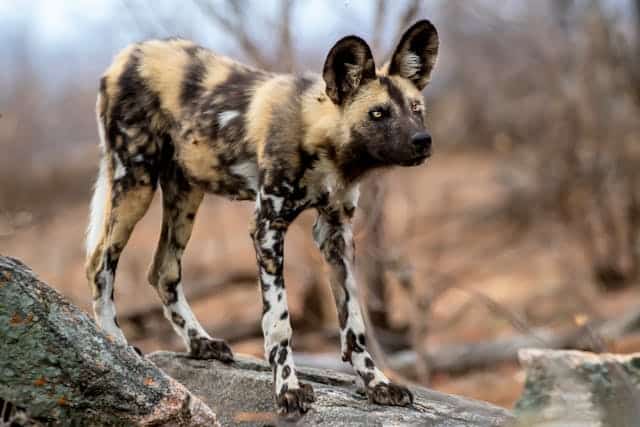
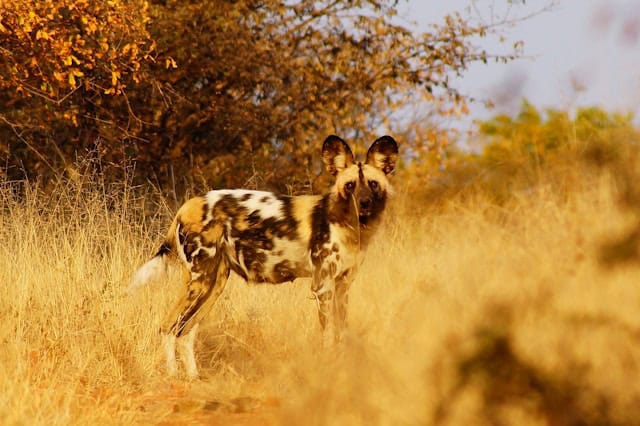
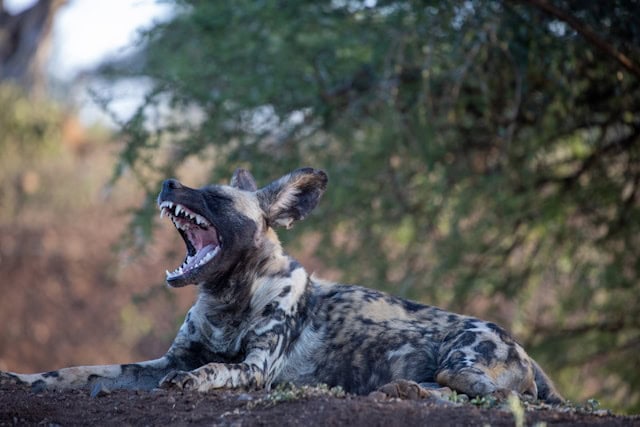
- Each dog has individual characters, distinct skills, and behaviors, making it one of Africa’s most difficult-to-understand creatures.
- Painted Dogs have incredible hearing, with large bat-like ears and muscles that allow the ears to swivel to detect minute sounds in the distance.
- They have slim bodies, black muzzles, and long legs.
- Unlike domestic dogs, they only have four toes per foot.
- They have a bushy tail with a white tip, which scientists believe keeps dogs aware of where the rest of their packs are when hunting.
- The average adult is about the same size as a domestic Labrador, measuring 30 inches in height and 30 to 56 inches in length, and weighs between 40 to 70 pounds.
- Wild dogs communicate using touches, tail wags, and multiple vocalizations, including barks, howls, and a bell-like contact call that can be heard over long distances.
- They also use complex greeting rituals that include twittering and whining.
- They are a crepuscular species most active during dawn and dusk.
- They are carnivores and eat warthogs, gazelles, impalas, wildebeests, rats, birds, and other animals.
- They are among the most efficient hunters on the planet. They hunt in packs, requiring extraordinary cooperation and teamwork to pursue their prey for up to an hour and rarely letting it escape.
- They use their excellent eyesight to locate a herd of prey. A dominant individual usually sneezes to start voting for a hunt, and the rest of the pack, in agreement, continues to sneeze to vote. Then, the alpha male typically walks up to its prey without ambush to initiate the hunt. Once the herd stampedes, they follow them and pick out the weakest member, repeatedly biting it on the legs and belly, running it to exhaustion to kill it.
- They are primarily found in arid zones, savannas, woodland, scrublands, and mountainous habitats in Tanzania, northern Mozambique, and southern Africa.
- Painted dogs’ sightings are scarce because they are elusive and never stay in one place long.
- They are nomads, can travel up to 50 kilometers per day, and occupy territories of up to 1,500 square kilometers.
- When not hunting, they rest near waterholes, using their large ears to dissipate heat and keep them cool.
- It is impossible to domesticate them due to their genetic framework.
- They can reach more than 44 miles per hour, like a Greyhound.
- They are very social and intelligent and live in groups called packs of 10 to 40 individuals. They have a unique social structure similar to North American wolves, guided by a dominant breeding pair (the alpha male and alpha female) that usually remains monogamous for life.
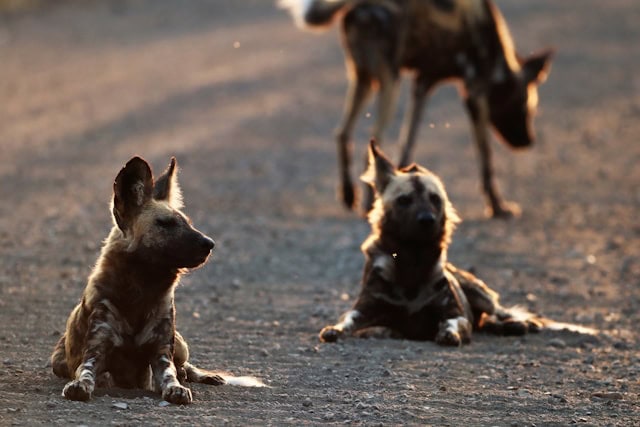
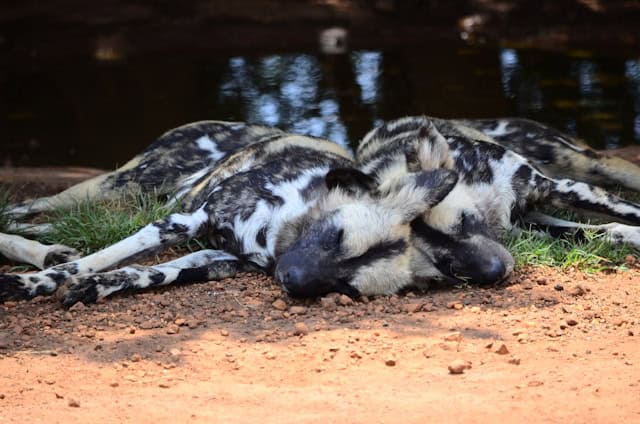
- They form strong bonds, showing care and support to pups, injured, ill, and elderly pack members by sharing food, even when the weak individual can’t participate in the hunt.
- When the hunters return, they feed the nursing females and pups regurgitating meat to the point that non-breeding adults sacrifice their nourishment to ensure they get enough to eat and grow, gradually becoming malnourished and dying younger.
- The Painted Dog alpha female uses abandoned underground dens to give birth to a large litter of 10 to 11 pups per year, but very few pups survive.
- When the female Painted dogs mature, they migrate to a new pack instead of males like in other species.
- All male dogs within a pack are related, and some assume roles as guards, stationing around the dens to protect the pups from predators.
- They live up to 11 years in the wild.
- There are less than 7,000 in the wild, and only 1,500 of these are adults; therefore, they are officially classified as endangered on the IUCN Red List due to conflicts with humans that kill them thinking that they prey on their livestock, habitat fragmentation due to agriculture, settlements, and roads, and epidemic diseases such as rabies, parvovirus, and distemper.
Books About Painted Dogs
Reading to your children about these mammals is one of the best educational activities you can do to teach your kiddos about anything, mainly if you use books filled with amazing pictures and illustrations.
Books about these incredible animals can be found at your local library, used book store, and on Amazon. I added my Amazon links to the titles to make it easier for you to find them and purchase some.
- Wild African Dogs by Tristan Walters. Packed with ferocious facts, stunning photography, and engaging puzzles, this book will fuel curious young minds and inspire the next generation of wildlife lovers.
- Facts About the Wild African Dog by Lisa Stratin is an educational children’s picture book that presents facts, full-color photographs, and carefully chosen words to teach children about the African Wild Dog.
- African Wild Dogs by Victoria Blakemore is an exciting and informative book about the life and behavior of African wild dogs. It covers their physical characteristics, habitat, family life, behavior, and conservation.
- African Wild Dog by Grant Publishing is a book filled with roaring facts and ferocious photography, perfect for curious young minds and nature lovers.
- African Wild Dogs for Kids by Rachel Smith offers information about the African wild dog, often neglected when discussing canids. It explains how this exciting animal is different from other dogs in some ways and very much like them in others.
- Africa’s Wild Dogs: A Survival Story by Joselin Kagan shows how, If left to their own devices, these dogs are more than capable of thriving, as this sumptuous photographic natural history shows, according to world experts’ latest findings about these resourceful, graceful and highly skilled family groups.
- Remembering African Wild Dogs by Margott Ragget aims to create the most beautiful photographic book ever seen on this species and use it to raise awareness of that animal’s plight and funds to protect it. It is full of images generously donated by many of the world’s top wildlife photographers. All profits from the sale of this book will be donated to projects working to protect wild dogs in Africa.
- Spots the African Painted Dog by Shira Ziegler. This nine-year-old author loves animals and nature.
- An African Painted Dog Without a Patch by Anna Grob is an exciting tale with delightful illustrations about a mischievous painted dog who learns life lessons through his experience away from his pack, with a touch of humor that children will love and learn about the magnificent animals of Africa.
Pin It For Later
If you are in a rush and don’t have time to read the post and download the printable but want to save it later, pin it to one of your Pinterest boards.
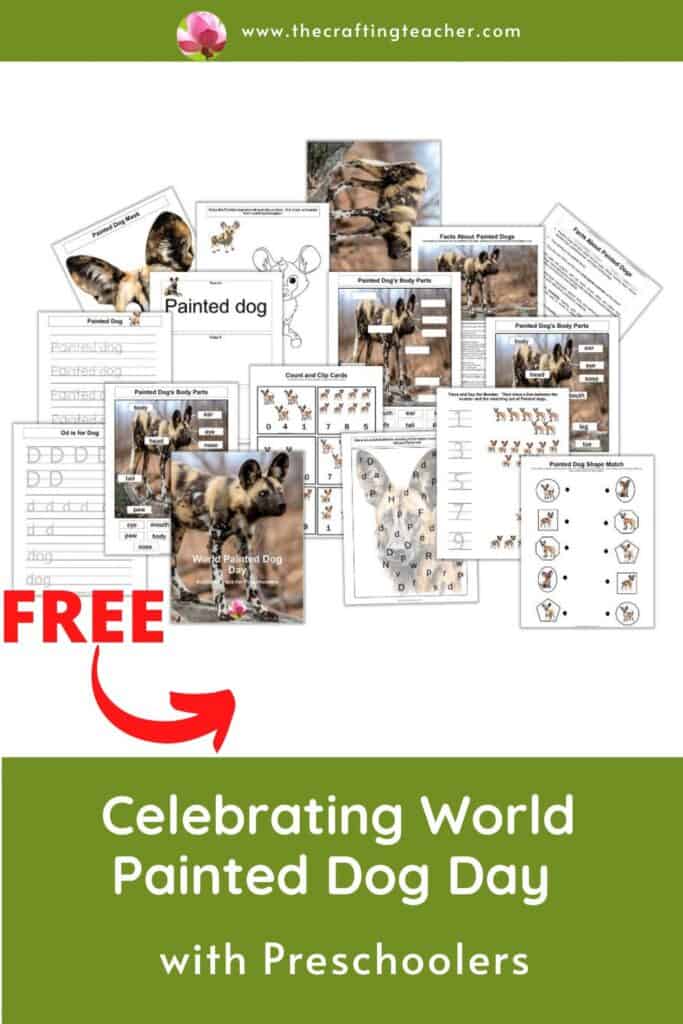
Suppose we all get united and do everything we can to spread the word, create awareness about the terrible situation Painted Dogs and other species face, and inspire our preschoolers’ desire to become defenders of the planet and its inhabitants for life. In that case, future generations will have the opportunity to get to know and enjoy these rare mammals and other existing species in danger of extinction.
I hope you enjoy these ideas and help you have fun during the International Wild Painted Dog Day celebration with your preschoolers. To get the FREE pack, click on the link below and put your information for an immediate download.
Be happy, safe, and creative. I wish you well.
Love,

P.D. Please let me know if any of these ideas worked for you or if you think I need to add or replace something. My goal is to help you in any way I can.

